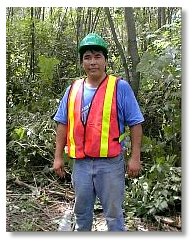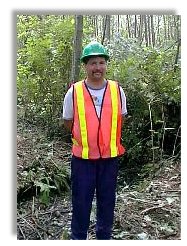Working with the Salmon
By Damien Barstead
The value of salmon in any context is enormous. Economically, their harvest brings in revenue; socially, they bring tourism and industry to our lands; politically, they cause international conflicts over their "ownership"; and ecologically, they are one of the most basic and important components of our food web. With just these few examples it is quite easy to see why we have taken so many, but much harder to see why we have left so few. This unbalanced supply and demand equation results in many unemployed fish harvesters due to the decreasing numbers of fish. Fortunately, we in the conservation game often tend to benefit from this surplus labour.
The North Island Fisheries Initiative (NIFI) is a program designed to provide the means to re-train commercial fishermen from the region who have been displaced from their jobs, due to imposed harvesting restrictions.

Arnold Wilson working on the
creek restoration project.
These men and women have the option to receive training in virtually any field or industry that they choose. Since most of these displaced fisheries workers already have a certain comfort level working with fish, it only seems natural that many end up within the same general industry, but on the flip side of the industry pyramid.
|
The Haig-Brown Kingfisher Creek Restoration Project has hired two employees from NIFI to provide the hand labour essential to creating the new stream channel. Arnold Wilson and Mike Dick are on-site clearing brush, fine tuning the excavated channel, hand digging off-channel habitat, and happily doing anything else that may arise.

Mike Dick, working on the
creek restoration project.
They were chosen for this job, partially due to their versatility, but also because of the training that they have received. Both have completed the first three modules of "Streamkeepers." These modules include survey techniques for preliminary assessments, stream habitat identification and measuring, and invertebrate identification and classification. As well, both workers have completed 10-15 other forestry and outdoor courses in their re-training program.
When asked what the greatest benefits for working in this stream creation project are, Wilson explained, "Its great how every day, you see it come together." He also exclaimed several times about how much 'fun' the project is, and while looking over the trenched excavation site, quoted a comment from an earlier conversation with Ken Enns, "Its like playing in the dirt in your back yard when you were a child, only much bigger." The end result of these two NIFI workers’ retraining is that they are able to give a little something back to the salmon that was once their livelihood.
Top of page.
|

